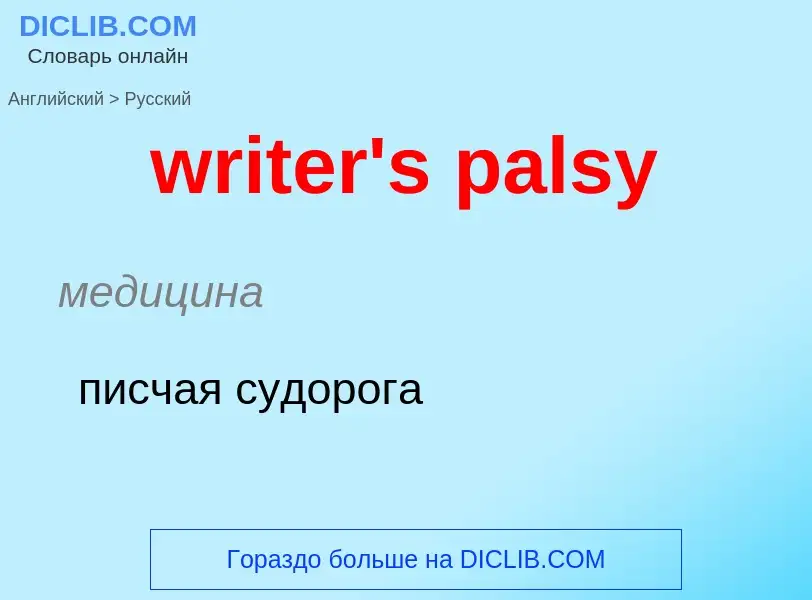Перевод и анализ слов искусственным интеллектом ChatGPT
На этой странице Вы можете получить подробный анализ слова или словосочетания, произведенный с помощью лучшей на сегодняшний день технологии искусственного интеллекта:
- как употребляется слово
- частота употребления
- используется оно чаще в устной или письменной речи
- варианты перевода слова
- примеры употребления (несколько фраз с переводом)
- этимология
writer's palsy - перевод на русский
медицина
писчая судорога
Определение
Википедия

Cerebral palsy (CP) is a group of movement disorders that appear in early childhood. Signs and symptoms vary among people and over time, but include poor coordination, stiff muscles, weak muscles, and tremors. There may be problems with sensation, vision, hearing, and speaking. Often, babies with cerebral palsy do not roll over, sit, crawl or walk as early as other children of their age. Other symptoms include seizures and problems with thinking or reasoning, each of which occur in about one-third of people with CP. While symptoms may get more noticeable over the first few years of life, underlying problems do not worsen over time.
Cerebral palsy is caused by abnormal development or damage to the parts of the brain that control movement, balance, and posture. Most often, the problems occur during pregnancy, but they may also occur during childbirth or shortly after birth. Often, the cause is unknown. Risk factors include preterm birth, being a twin, certain infections during pregnancy, such as toxoplasmosis or rubella, exposure to methylmercury during pregnancy, a difficult delivery, and head trauma during the first few years of life, among others. About 2% of cases are believed to be due to an inherited genetic cause. A number of sub-types are classified, based on the specific problems present. For example, those with stiff muscles have spastic cerebral palsy, those with poor coordination in locomotion have ataxic cerebral palsy, and those with writhing movements have dyskinetic cerebral palsy. Diagnosis is based on the child's development over time. Blood tests and medical imaging may be used to rule out other possible causes.
Some of the causes of CP are preventable through immunization of the mother, and through efforts to prevent head injuries in children such as through improved safety. There is no known cure for CP, but supportive treatments, medication and surgery may help many individuals. This may include physical therapy, occupational therapy and speech therapy. Medications such as diazepam, baclofen and botulinum toxin may help relax stiff muscles. Surgery may include lengthening muscles and cutting overly active nerves. Often, external braces and Lycra splints and other assistive technology are helpful with mobility. Some affected children can achieve near normal adult lives with appropriate treatment. While alternative medicines are frequently used, there is no evidence to support their use.
Cerebral palsy is the most common movement disorder in children. It occurs in about 2.1 per 1,000 live births. Cerebral palsy has been documented throughout history, with the first known descriptions occurring in the work of Hippocrates in the 5th century BCE. Extensive study of the condition began in the 19th century by William John Little, after whom spastic diplegia was called "Little's disease". William Osler first named it "cerebral palsy" from the German zerebrale Kinderlähmung (cerebral child-paralysis). A number of potential treatments are being examined, including stem cell therapy. However, more research is required to determine if it is effective and safe.


![Amsterdam Gait Classification]] facilitates the assessment of the gait pattern in CP patients. It helps to facilitate communication in the interdisciplinary team between those affected, doctors, physiotherapists and orthotists. Amsterdam Gait Classification]] facilitates the assessment of the gait pattern in CP patients. It helps to facilitate communication in the interdisciplinary team between those affected, doctors, physiotherapists and orthotists.](https://commons.wikimedia.org/wiki/Special:FilePath/Amsterdam Gait Classification gb.jpg?width=200)
![Researchers are developing an electrical stimulation device specifically for children with cerebral palsy, who have [[foot drop]], which causes tripping when walking. Researchers are developing an electrical stimulation device specifically for children with cerebral palsy, who have [[foot drop]], which causes tripping when walking.](https://commons.wikimedia.org/wiki/Special:FilePath/Cerebral palsy.jpg?width=200)
![Child with cerebral palsy and [[orthotics]] with adjustable functional elements to improve safety when standing and walking. Child with cerebral palsy and [[orthotics]] with adjustable functional elements to improve safety when standing and walking.](https://commons.wikimedia.org/wiki/Special:FilePath/Cerebralparese Orthese orthotics.jpg?width=200)
![[[Micrograph]] showing a fetal ([[placenta]]l) vein thrombosis, in a case of [[fetal thrombotic vasculopathy]]. This is associated with cerebral palsy and is suggestive of a [[hypercoagulable state]] as the underlying cause. [[Micrograph]] showing a fetal ([[placenta]]l) vein thrombosis, in a case of [[fetal thrombotic vasculopathy]]. This is associated with cerebral palsy and is suggestive of a [[hypercoagulable state]] as the underlying cause.](https://commons.wikimedia.org/wiki/Special:FilePath/Fetal thrombotic vasculopathy - intermed mag.jpg?width=200)
